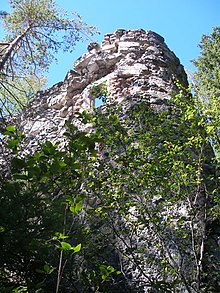Sigmundsburg ruins
The castle ruins of Sigmundsburg (sometimes also called Sigmundsberg ) stand - completely covered by forest - on an island in Fernsteinsee . The area belongs to the municipality of Nassereith in the Imst district in Tyrol .
history
Sigmundsburg Castle was built by Duke Sigmund der Münzreich. It was a "homage" (Arnold-Öttl) to his first wife, the Scottish king's daughter Eleonore , whom he married in 1449. After the completion of the palace in 1463, Eleonore stayed in the palace, which she preferred to the “Hofburg teeming with guests” in Innsbruck . The Duke must have used it at hunting parties in the game-rich area. Fishing was also enjoyed on the trout-rich lake, for which there were four boats. The remote castle also served occasionally as a place of refuge, in 1463/65 from a rampant epidemic and in 1478 from the Turks .
Building bills prove that work was done on the castle again and again during Sigmund's lifetime, but it was never fully completed. From the chapel, which even received an indulgence in 1471 , it is said in 1574 that “the little church was completely empty and never expanded”.
After Sigmund had to hand over government affairs to King Maximilian I at the massive pressure of the Tyrolean estates in 1490 , he was likely to have chosen Sigmundsburg as his place of residence several times until his death. Maximilian also valued the cheap hostel on his hunts in the Ausserfern . After that, the castle lost its function and was about to deteriorate. In 1703 it was said that it was “now deserted” and in 1775 that “the collapsed Sigmundsburg Castle should be kept much more for a pile of stones than for an apartment”.
In the 19th century, King Maximilian II of Bavaria showed interest in the castle ruins. But the plans for a reconstruction or conversion did not come to fruition. His son Ludwig II also came here and had a red and blue room set up as secret quarters in Fernstein in 1872.
construction
The Sigmundsburg never had a special military function, rather the fortifications and Klause Fernstein on the medieval road over the Fernpass served this purpose . Therefore, the characteristic features of a castle are missing. The castle on the Inselberg consisted of an almost square building with towers on every corner and a two-story chapel in the east. The interior divides a central wall on which a steep hipped roof rested. Stonemasons' marks on the stones of the chapel and the windows are assigned to the building works of Master Heinrich from Imst . In 1952 security work in the chapel began, but was not continued. An illustration in the Tiroler Burgenbuch from 1986 still shows the arches of two Gothic windows. In 2012 it was only one.
Sigmundsburg Castle is a “special case” in Tyrol (Arnold-Öttl). The Loire castles could have influenced the design of the building . Sigmund's first wife Eleonore lived there before she got married and Sigmund also saw these castles.
literature
- Herta Arnold-Öttl: Sigmundsburg . In: Oswald Trapp: Tiroler Burgenbuch , Volume VII (Oberinntal and Ausserfern) 1986, pp. 247-268, ISBN 88-7014-391-0 .
- Gerhard Stenzel: From castle to castle in Austria. Verlag Kremayr & Scheriau, Vienna, 1978 (p. 276). ISBN 3 218 00278 8 .
Web links
Coordinates: 47 ° 20 ′ 42.5 ″ N , 10 ° 49 ′ 25.7 ″ E

